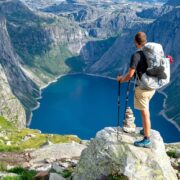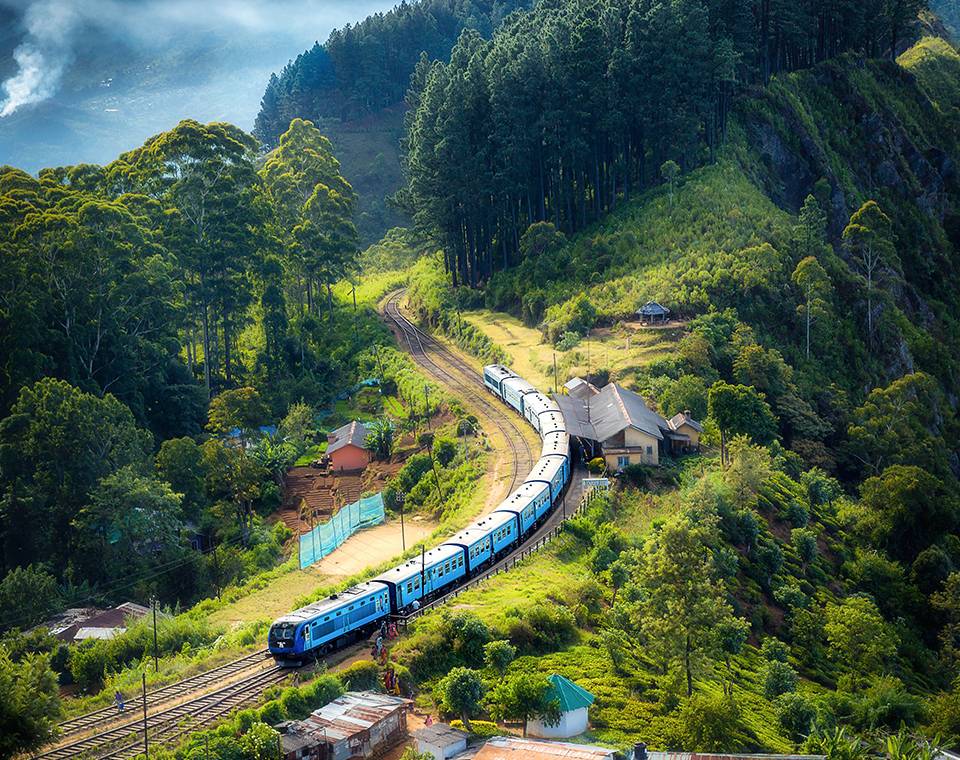
Top Places to Go on a Walking Safari in East Africa
On foot in the vast wilderness, exposed, all senses on high alert. The gentle breeze rustles through the dry leaves, a twig snaps underfoot. One eye on your guide watching for his reactions, whilst also trying to scan the surrounding wilderness, all while ensuring each footstep is carefully placed. There is little that compares to the excitement of a walking safari in the wild expanse of East Africa in October.
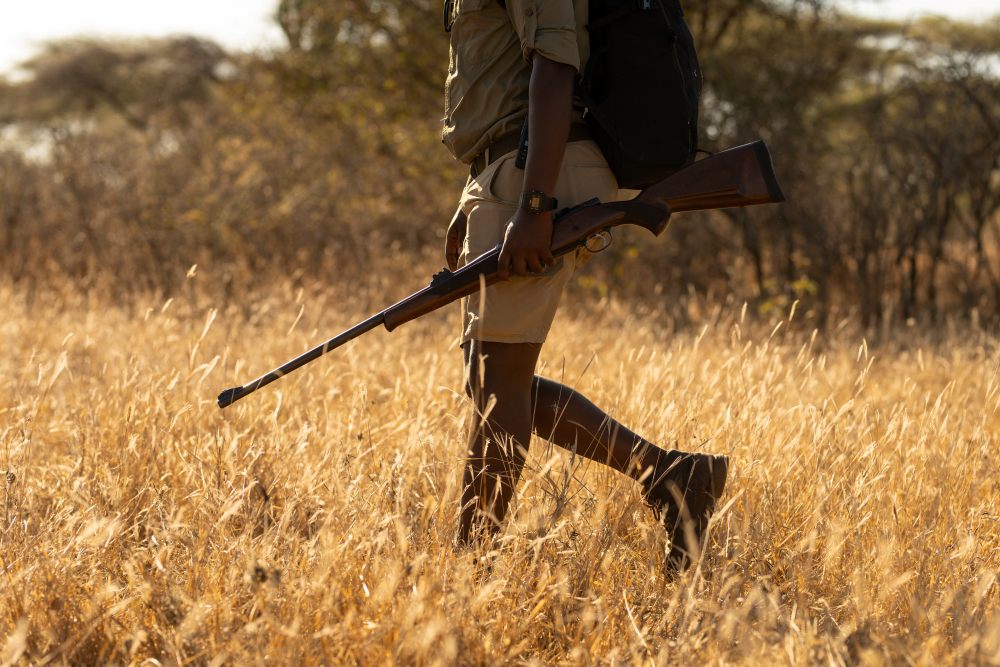
While most first-time safari-goers tend to opt for game drives, a walking safari in Southern Tanzania is a wonderful experience for returning safari goers looking to experience the plains of Africa in a completely different light. While game drives allow you to observe nature form a safe distance, a walking safari allows you to truly immerse yourself in your surroundings, making you a part of the ecosystem.
Both Tanzania and Kenya have excellent walking safari experiences, but for those looking to truly get off the beaten track and try a safari experience that brings all the awe without the crowds, a southern Tanzania walking safari is the perfect way to do that. Below, we’ve narrowed down the top places to go on safari in East Africa so you can start planning your next East Africa safari!

Top Places to Go on a Walking Safari
Nyerere National Park, Southern Tanzania
One of the largest national parks in Africa, Nyerere (formerly Selous) is nearly four times the size of its northern Tanzanian cousin, the Serengeti. Still, Nyerere remains relatively uncrowded in comparison even though it offers equally stellar game viewing opportunities. A walking safari through Nyerere is one of the best ways to explore the park’s prime game viewing spots and secure views of wonders such as the great Rufiji River.

Nyerere has much of the prime wildlife one would expect from a more popular park. The area is known for its strong wild dog population and is also home to the Big 5, although rhino are exceptionally rare to see. Big cats here include lion and leopard, and you can expect to see large herds of elephant and buffalo. Hippo and crocodile lurk on the banks and in the waters of the Rufiji, and there are some 450 bird species present which make this an excellent birding destination.
Where to stay: Roho ya Selous
Serengeti National Park, Northern Tanzania
Walking through the Serengeti is an experience unlike any other, even for those who have previously traversed the open savannas that make up this national park. While game drives during peak season lead you to cross paths with many a tourist in search of the next Great Migration phase, exploring the Serengeti on foot takes you to quieter areas off the beaten track so vastly contrasting the bustle of the rest of the safari-vehicle trodden park that you’ll be forgiven for questioning if you are still in the Serengeti.
With no crowds around to deter the wildlife, you will have front-row seats to witness the circle of life as closely as possible. Observe granular ecosystems found amongst rocks and trees and follow as your guide tracks wildlife and points out interesting findings. While the bigger and more common wildlife finds aren’t the sole focus on a walking safari, you can still expect to see elephant, zebra, and more. If you’re lucky, you may even come across lion on the hunt, stealthily stalking their prey as you watch with baited breath.
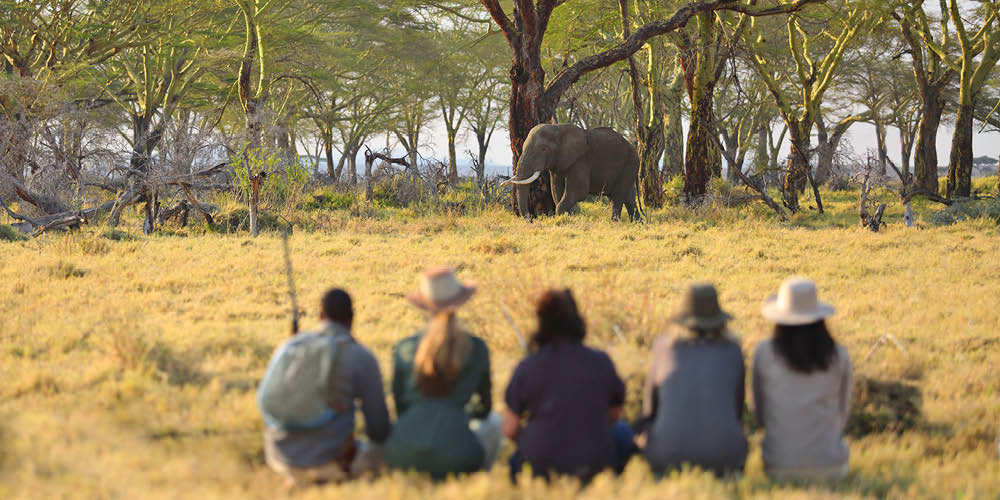
Where to stay: Sayari Camp, Namiri Plains, Ubuntu Migration Camp
Arusha National Park, Northern Tanzania
A lesser-known safari heavyweight, Arusha National Park lies at the foot of one of the highest mountains on the continent- Mount Meru, a dormant but active volcano. The park’s diverse landscapes and fascinating wildlife have long attracted safari-goers in search of hidden gems and out-of-the-ordinary safari sightings on the Northern Tanzania safari circuit; a walking safari within Arusha is the perfect opportunity to experience every detail of the park up close.
From the lush rainforests to the scenic lakes, Arusha’s landscapes welcome exploration with wonder. This national park is home to an array of colourful and unique birdlife, including both lesser and greater flamingo and silvery cheeked hornbill. Notably, the Colobus monkey is one of the rarest and most attractive park residents for visitors. You can also expect to see towers of giraffe, herds of buffalo, and dazzles of zebra, and while big cats such as lion aren’t present, if you’re lucky you may catch sight of the elusive leopard as well as packs of hyena.
Mara Naboisho Conservancy, Kenya
A walking safari within Kenya is a particularly unique experience as many of the country’s national parks and reserves do not allow walking safaris. But, fret not, some of the private conservancies both within and surrounding the parks are the exception, allowing for guided walking safaris. Mara Naboisho Conservancy is one such conservancy, renowned as the second largest within the Greater Mara Area, with an unfenced boundary to the Maasai Mara Reserve.
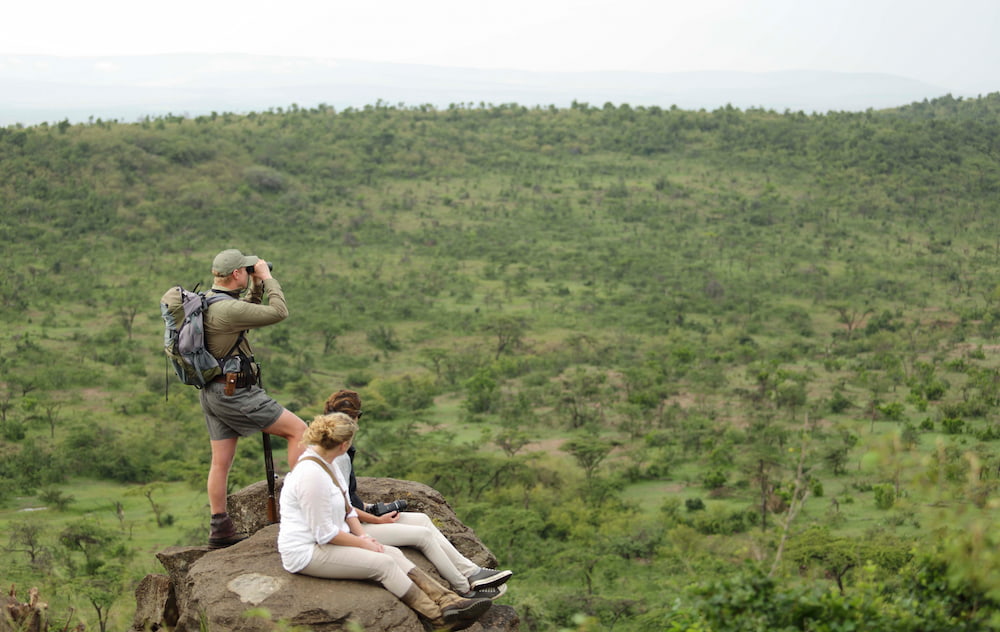
Adding to its appeal, the Mara Naboisho Conservancy also has one of the richest concentrations of wildlife within the Mara with a few top-of-the list wildlife finds present in large numbers. The Mara is home to one of the highest concentrations of lion across the continent with the largest pride, made up of around 20 lion, located within Mara Naboisho Conservancy. While you may see the Big 5 in the Maasai Mara and elephant are present in large numbers, rhino are far harder to come by.
For those interested in immersing themselves in the Maasai communities, guided walks through local villages can be arranged.
Where to stay: Naboisho Camp
Ngorongoro Conservation Area, Northern Tanzania
As the domicile of the largest intact caldera in the world, the Ngorongoro Conservation Area already holds much acclaim; but there’s more to the conservation area than its active crater. The Ngorongoro Conservation Area is both a protected area and a UNESCO World Heritage Site, home to around 25,000 animals most of which are ungulate herds, as well as a wealth of plant life and varying landscapes.
A walking safari within the Ngorongoro Conservation Area can take many forms, each with differing lengths, routes, and sights to see. You can venture through the forests that surround the Ngorongoro Crater, explore the crater’s rim, or discover the savannas, grasslands, lakes and mountains and other landscapes spread across the 8094 km^2 (3125 square miles) of land. Visit the local Maasai communities and meet the Maasai people, or enjoy the diverse plant and wildlife.
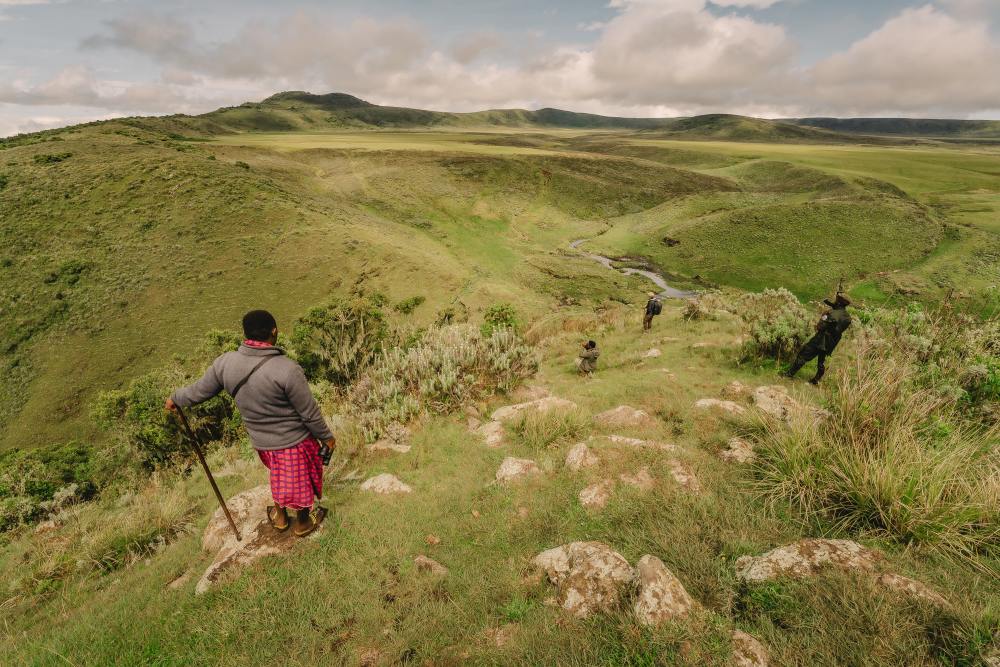
The area hosts a healthy predator population with leopard, lion and cheetah all being present, and if the Big 5 is what you seek, you will find all members of the game family present within the Ngorongoro Crater, however walking safaris within the actual crater are not permitted. If you are a bird enthusiast, a walking safari within the wider conservation area will also prove particularly rewarding, with over 400 species of bird present. A walk here promises an experience that will leave you feeling fulfilled, and ready to retire in comfort at our unique Ngorongoro property.
Where to stay: The Highlands
When to Go on a Walking Safari in East Africa
Choosing the right season
By early June, the season of the long rains in East Africa has usually come to an end, leaving the landscape in many of the parks green and lush with thick vegetation and tall grasses. Rivers are flowing, lakes and watering holes are full, and wildlife is typically spread out enjoying the abundance of nutritious grazing and easy access to water. However, as the dry season begins to take hold, the vegetation thins and water sources dwindle, setting the stage for perfect game viewing conditions.

Across all northern and southern Tanzania, the dry months are marked as high season, and with good reason. The northern Serengeti turns into a show ground as thousands of tourists descend upon the Mara River area hoping to witness the spectacle of a river crossing by the migrating herds. Tarangire National Park, one of the most underrated and overlooked parks in northern Tanzania, offers the area’s only permanent water source throughout the dry season, attracting incredible numbers of mammals from all the surrounding areas into the park, creating phenomenal game viewing opportunities. However, on the topic of overlooked and underrated, there is little that compares to the limited attention that southern Tanzania receives. The vast landscapes of Nyerere and Ruaha national parks offer a wild and wildlife rich safari experience with a level of exclusivity unheard of in northern Tanzania. And, as per the rest of East Africa, the dry season has a profound impact on the experience offered.
Walking in October
October is usually the last full calendar month of the dry season in Tanzania. In November, the humidity starts to build, and the afternoons increasingly see the threat of a rain shower. Eventually, the clouds burst, and the first rains fall, their moisture swallowed by the parched earth and dry vegetation within seconds.
As the afternoon showers settle into a regular cadence, so the landscape once again transforms, turning green and lush as the vegetation regrows and thickens. Arriving in southern Tanzania ahead of the short rains is crucial if you are here for the incredible walking this region offers. By October, the effects of dry season are approaching their most severe, arguably creating the best safari conditions in Africa.

Any guided walk through the bush can be called a walking safari. However, not all walking safaris are created equal, as those who have experienced more than one walking safari will be able to attest. The condition of the bush is a crucial factor that needs to be carefully considered. During, or shortly after the rainy seasons, the bush is thick and lush resulting in poor visibility and a potentially dangerous situation as predators cannot be seen from a distance.
Apart from the safety element, the vegetation also limits what you can see from an interest perspective, limiting your experience to the immediate path ahead. Grasses are often high and carry ticks or a variety of other insects after the rains, again creating an uncomfortable walking environment.
After three months of a progressively developing dry season, October brings about the ultimate playground for the walking safari enthusiast. The grass is dry and very low – tick and insect free. Trees and bushes have generally lost most of their leaves and all surrounding vegetation is considerably less dense. The improved visibility allows for a wider field of vision, a safer walking experience, and the ability to actively track big game from a safe distance.

Most importantly, an experienced and knowledgeable guide is an absolute prerequisite. If you’re walking with an Asilia guide, you’re in good hands. All our walking guides have at least 100 hours of field-based guided walking safari experience, a certificate in advanced rifle handling, and a certificate of competency in the handling of dangerous game. These are our most experienced guides, and their passion for a walking safari is what makes them great. Their love of the wilderness is what drives them, and they are excited to share it with you.
The experience
After a light breakfast in camp and a pre-walk safety briefing, strike out on foot into the surrounding wilderness. Following behind your Asilia walking guide in single file, the sanctuary of camp quickly disappears from view and the enormity of your surroundings comes into focus. The brain seems to recognise this shift away from the ordinary, as senses are suddenly primed and dialled up to “sensitive”. Without the din of a heavy diesel engine running in the background, almost every sound is now audible, from Fish Eagles overhead to the grasshoppers hiding in the short grass.
The warm breeze carries the constantly changing notes of the surrounding vegetation, and sometimes the decay of a kill before it even comes into sight. Occasionally, the opportunity arises to track large mammals as they meander towards watering holes or devour the remnants of last night’s kill, but much of the walking safari experience is in the observation of the smaller ecosystems that all play a crucial role in the health of the environment. There are animal tracks to examine and identify, scent markings, termite mounds, insects, burrows and nests – all of which is frequently unseen or ignored from the height of a vehicle.
Ruaha and Nyerere national parks offer a diverse and varied safari experience between not only each other, but also when compared to the parks of northern Tanzania. At the height of dry season in southern Tanzania, the landscape, wildlife, and access to water align to create perfect walking safari conditions. Nyerere National Park offers a superb diversity of habitat across river systems and forested areas thick with riverine trees. The landscape feels genuinely wild and unexplored, creating an incredible wilderness experience.

Walking along the banks of the waterways and lake systems in the vicinity of Roho ya Selous make for exciting opportunities to view hippo arguing over territory in the dwindling waters, and the interactions between crocodile as they bask in the sun.
In Ruaha National Park, the sandy bed of the dry Mwagusi River is patterned with animal prints. Elephant use their tusks and trunks to dig beneath the sandy surface to the cool water below, opening a temporary well point which other wildlife look to utilise after the elephant have moved on. Prides of lion lazily lounge under the trees on the banks, half an eye open in case an easy meal appears within range. To simply sit in the cool of the shade, absorbing the sounds and smells of the bush, whilst overlooking the sights of a watering hole below you. These are the memories that last a lifetime.
A walking safari offers a unique departure from the comfort and elevation of a vehicle, allowing for a closer connection to the environment and a heightened awareness of your place within it. Exploring on foot in East Africa is arguably one of the very best safari experiences attainable in East Africa. Whether you are a seasoned walking safari enthusiast, or eager to experience this thrill for the first time, a walking safari in East Africa should be on your bucket list.
Enquire today to start planning your East Africa walking safari experience.
Recent Posts
Top Safari Activity Alternatives to Game Drives
The Cradle of Mankind: East Africa’s rich history
Africa’s Hidden Safari Gems: Where to Go on Your Second Journey
All Categories

Thailand




